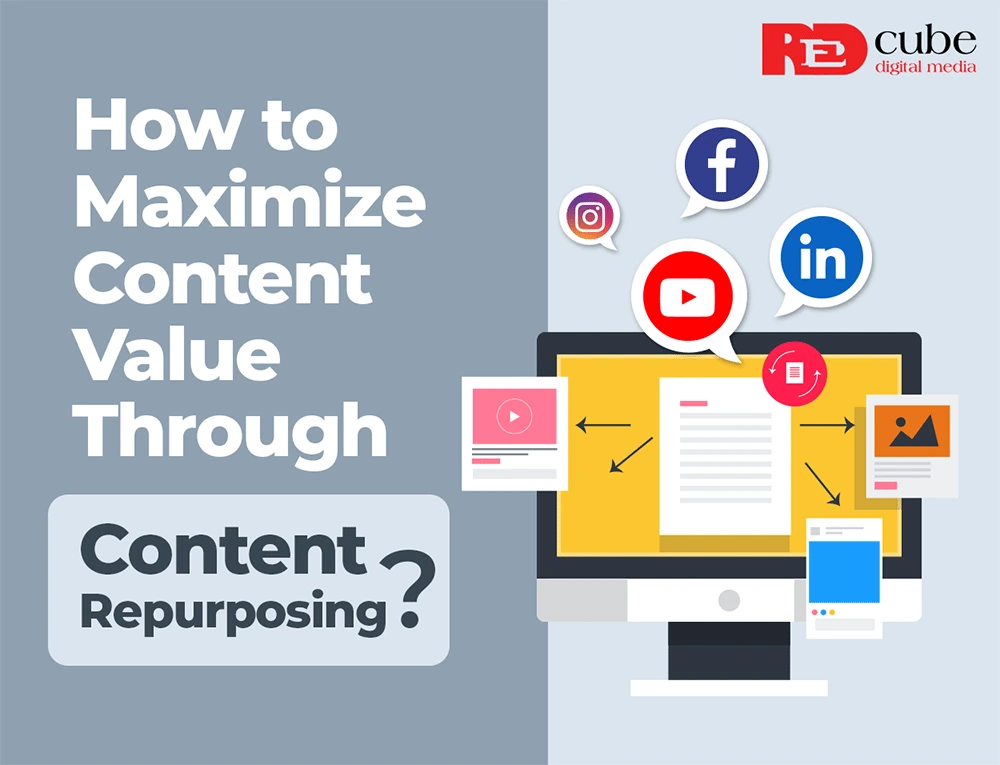Have you ever felt overwhelmed by the demand to create unique content for every social media platform? How much time and effort do you spend trying to reach different audiences with varying messages? What if there was a more efficient way to make your mark across all platforms? Let’s explore the fascinating world of repurposing content – a game-changing approach that could transform your social media strategy for the better.
Understanding Content Repurposing
Content repurposing means taking a single piece of content and adapting it into various formats. For example, a detailed blog post can be turned into a podcast episode, an infographic, or a series of social media posts. This allows you to cater your content to different audience preferences and extend the lifespan of your content. It can be an optimum approach to gain maximized results through each piece of content.
4 Major Benefits of Content Repurposing
1. Increased Reach
- Your content can easily reach different media platforms.
- It will be available to every kind of audience.
- Some people may prefer reading blogs, while others might prefer watching videos or listening to podcasts.
- It allows you to grab the attention of different audience segments easily.
- This multi-channel approach ensures that your content is accessible to a wider audience.
2. Improved SEO
- Repurposing content helps in creating multiple backlinks to your original content, making your website’s SEO ranking better.
- It also allows you to target different keywords to increase visibility in search engine results.
- For example, transforming a blog post into a video or an infographic can attract new backlinks from sites that specialize in different formats.
- It enhances your overall search engine performance.
3. Enhanced Engagement
- Different formats can engage different types of your audience.
- A single piece of content can attract more attention when it’s available in different formats.
- For example, a video on YouTube, a post on LinkedIn, a story or post on Instagram, or an infographic on Pinterest.
- This variety keeps your audience engaged creating multiple ways to consume your content.
- It leads to higher interaction rates and a more widespread online presence.
4. Cost-Effective
- Creating new content from scratch can be time-consuming and costly.
- Repurposing allows you to use existing content, reducing the resources needed for content creation.
- By reusing existing materials, you can allocate your budget and manage time more efficiently.
- Focus on enhancing the quality and reach of your content instead of continually producing new material.
Steps to Effective Content Repurposing
1. Identify Evergreen Content
- Select content that remains relevant and popular over time.
- Evergreen content should not be related to current events or trends which makes it suitable for repurposing.
- This type of content has a longer shelf life.
- It can be continuously used to provide value to your audience.
- Examples include how-to guides, industry best practices, and foundational knowledge pieces.
2. Analyze Performance
- Always use analytics to determine which pieces of content have performed well.
- High-performing content is good for repurposing.
- Because it has already proven its value to your audience.
- Analyzing metrics such as page views, engagement rates, and social shares can help you identify the content that is consumed most by your audience.
- It makes sure that your repurposed efforts are focused on your most impactful and engaging material.
3. Choose the Right Formats
- Use formats that align with the preferences of your target audience when selecting formats.
- For example, professionals might appreciate a detailed whitepaper, while a general audience might prefer a more visual approach like an infographic.
- Surveys, audience feedback, and market research can provide insights into which formats will be most successful.
- Understanding your audience’s preferences and behaviors is important for deciding how to repurpose your content effectively.
4. Update and Refresh
- When repurposing, ensure that the content is updated.
- It should reflect any new information or changes in your industry.
- This keeps your content accurate, updated, and relevant.
- Regularly reviewing and updating your repurposed content ensures that it continues to provide value and new information and maintains its relevance over time.
- It is essential for maintaining audience trust and engagement.
5. Optimize for SEO
- When adapting content, optimize it for search engines by including relevant keywords and metadata.
- This will help in reaching a wider audience through organic search.
- Using SEO best practices, such as keyword research, meta descriptions, and internal linking, ensures that your repurposed content performs well in search engine rankings to drive more traffic to your site.
5 Prime Examples of Content Repurposing
Here are some detailed examples to illustrate how you can repurpose your content effectively:
1. Blog Posts to eBooks
A series of related blog posts can be compiled together to form a comprehensive eBook. For instance, if you have written several posts on digital marketing strategies, you can combine these into a well-structured eBook titled “The Ultimate Guide to Digital Marketing.” This eBook can then be used as a lead magnet to grow your email list or work as a downloadable resource on your website.
Steps:
- Select blog posts with a common theme or topic.
- Organize the content into chapters or sections.
- Add an introduction, conclusion, and additional insights.
- Design a visually appealing layout and cover.
- Offer the eBook as a free download in exchange for email sign-ups.
2. Webinars to YouTube Videos
Webinars are a valuable source of information that can be repurposed into video content for YouTube. For example, a webinar on “Effective Content Marketing Strategies” can be edited into shorter, focused videos covering specific topics discussed in the webinar. This approach helps reach audiences who prefer consuming content through video.
Steps:
- Record the webinar session.
- Edit the recording into shorter segments, each focusing on a key topic.
- Add titles, descriptions, and relevant tags for each video.
- Upload the videos to YouTube.
- Promote the videos through your social media channels and website.
3. Podcasts to Blog Transcripts
Transcribing podcast episodes into blog posts can help reach an audience that prefers reading over listening. For instance, a podcast episode featuring an interview with an industry expert can be transcribed and formatted into a blog post, providing readers with the same valuable insights in text form.
Steps:
- Transcribe the podcast episode.
- Edit the transcription for readability, removing filler words and adding headings.
- Embed the podcast audio in the blog post for those who prefer listening.
- Optimize the blog post with relevant keywords and metadata.
- Publish the blog post on your website and share it through your content distribution channels.
4. Social Media Posts to Infographics
Short, insightful social media posts can be transformed into visually appealing infographics. For example, a series of tweets or LinkedIn posts sharing tips on improving productivity can be combined into an infographic titled “10 Tips for Boosting Productivity.” Infographics are highly shareable and can drive traffic back to your website.
Steps:
- Gather a series of related social media posts.
- Identify the key points and tips to include in the infographic.
- Design tools like Canva or Adobe Illustrator can be used to create the infographic.
- Ensure the infographic is visually engaging and easy to understand.
- Share the infographic on social media and include a link to a detailed blog post on the same topic.
5. Whitepapers to Slide Decks
A detailed whitepaper can be repurposed into a slide deck for presentations or webinars. For instance, a whitepaper on “The Future of Artificial Intelligence in Business” can be broken down into key points and presented in a visually engaging slide deck. This slide deck can be used for webinars and conferences or shared on platforms like SlideShare.
Steps:
- Identify the key sections and points of the whitepaper.
- Create slides for each section, focusing on visuals and concise text.
- Add charts, graphs, and images to make the slides more engaging.
- Practice presenting the slide deck to ensure a smooth delivery.
- Share the slide deck on platforms like SlideShare and LinkedIn.
Content repurposing is a powerful strategy that can easily improve your content marketing efforts. By repurposing content, you can reach a broader audience, enhance engagement, and improve your SEO. Start identifying your best-performing content today.
Explore new formats to keep your audience engaged and informed. This approach ensures that your content remains valuable and relevant, ultimately maximizing its potential and impact.



